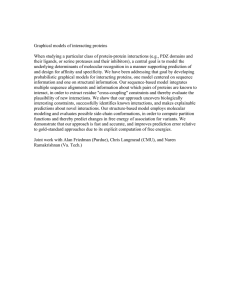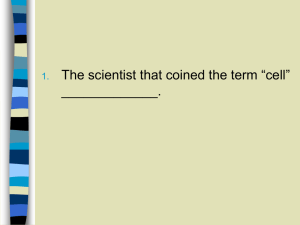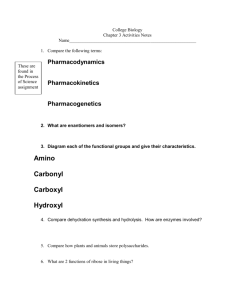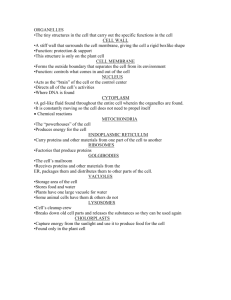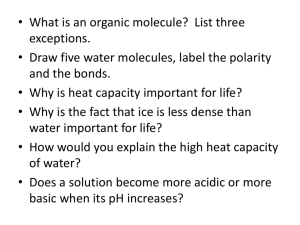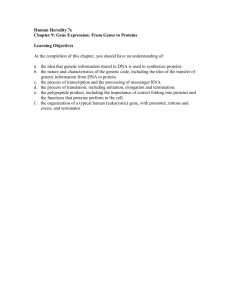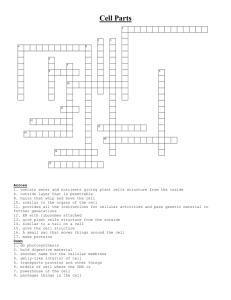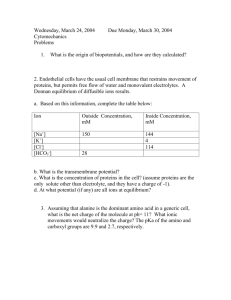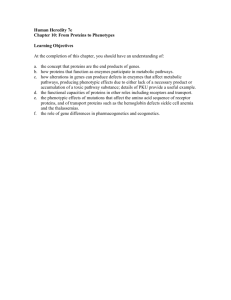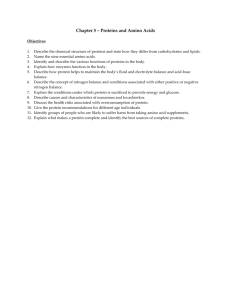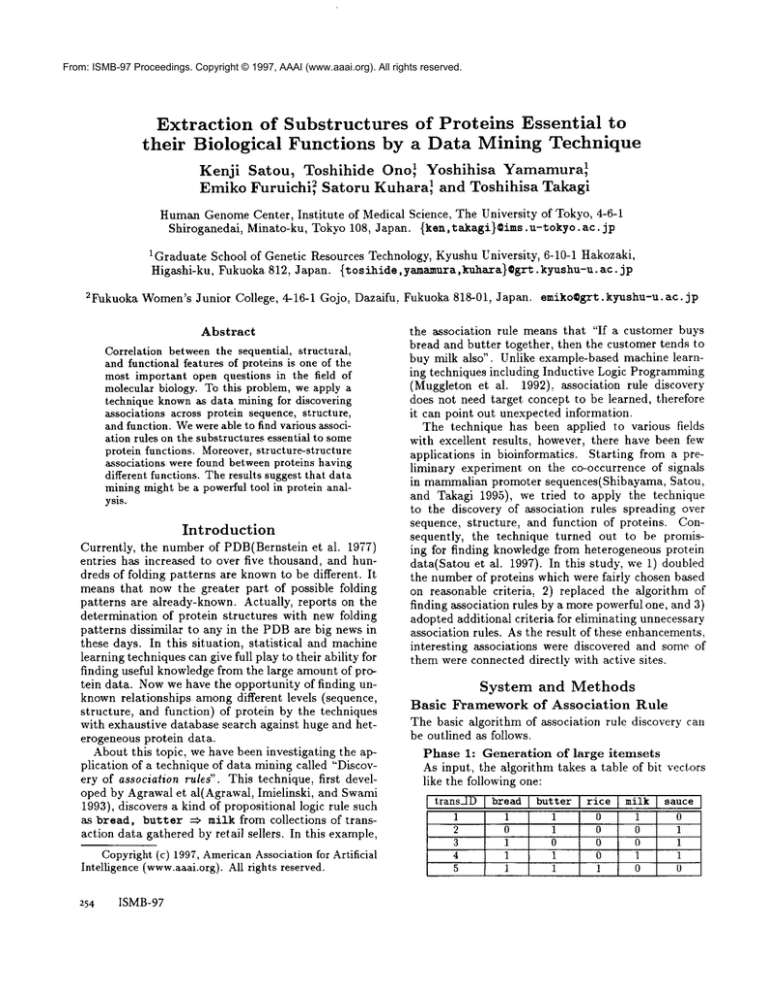
From: ISMB-97 Proceedings. Copyright © 1997, AAAI (www.aaai.org). All rights reserved.
Extraction of Substructures of Proteins Essential to
their Biological
Functions by a Data Mining Technique
Kenji
Satou,
Emiko Furuichi,
Toshihide
2 Satoru
Ono~ Yoshihisa
Yamamura~
Kuhara] and Toshihisa
Takagi
HumanGenomeCenter, Institute of Medical Science, The University of Tokyo, 4-6-1
Shiroganedai, Minato-ku, Tokyo 108, Japan. {ken,takagi}©ims.u-tokyo.ac.
jp
1Graduate School of Genetic Resources Technology, Kyushu University, 6-10-1 Hakozaki,
Higashi-ku, Fukuoka 812, Japan. {tosihido, yamamura,kuhaxa}©grt, kyushu-u, ac. jp
~Fukuoka Women’sJunior College, 4-16-1 Gojo, Dazaifu, Fukuoka 818-01, Japan. emtko©grt.kyushu-u, ac. jp
Abstract
Correlation betweenthe sequential, structural,
andfunctional features of proteins is one of the
most important open questions in the field of
molecular biology. To this problem, we apply a
technique knownas data mining for discovering
associations across protein sequence, structure,
and function. Wewereable to find various association rules on the substructures essential to some
protein functions. Moreover,structure-structure
associations were found between proteins having
different functions. The results suggest that data
mining might be a powerful tool in protein analysis.
Introduction
Currently, the number of PDB(Bernstein et al. 1977)
entries has increased to over five thousand, and hundreds of folding patterns are knownto be different. It
means that now the greater part of possible folding
patterns are already-known. Actually, reports on the
determination of protein structures with new folding
patterns dissimilar to any in the PDBare big news in
these days. In this situation, statistical and machine
learning techniquescan give full play to their ability for
finding useful knowledgefrom the large amountof protein data. Nowwe have the opportunity of finding unknownrelationships amongdifferent levels (sequence,
structure, and function) of protein by the techniques
with exhaustive database search against huge and heterogeneous protein data.
About this topic, we have been investigating the application of a technique of data mining called "Discovery of association rules". This technique, first developed by Agrawal et al(Agrawal, Imielinski, and Swami
1993), discovers a kind of propositional logic rule such
as bread, butter ~ milk from collections of transaction data gathered by retail sellers. In this example,
Copyright(c) 1997, AmericanAssociationfor Artificial
Intelhgence (www.aaai.org).All rights reserved.
254 ISMB-97
the association rule means that "If a customer buys
bread and butter together, then the customer tends to
buy n~lk also". Unlike example-based machine learning techniques including Inductive Logic Programming
(Muggleton et al. 1992), association rule discovery
does not need target concept to be learned, therefore
it can point out unexpected information.
The technique has been applied to various fields
with excellent results, however, there have been few
applications in bioinformatics. Starting from a preliminary experiment on the co-occurrence of signals
in mammalian promoter sequences(Shibayama, Satou,
and Takagi 1995), we tried to apply the technique
to the discovery of association rules spreading over
sequence, structure, and function of proteins. Consequently, the technique turned out to be pronfising for finding knowledgefrom heterogeneous protein
data(Satou et al. 1997). In this study, we i) doubled
the numberof proteins which were fairly chosen based
on reasonable criteria, 2) replaced the algorithm of
finding association rules by a more powerful one, and 3)
adopted additional criteria for eliminating unnecessary
association rules. As the result of these enhancements,
interesting associations were discovered and some of
them were connected directly with active sites.
System
and Methods
Basic Framework of Association
Rule
The basic algorithm of association rule discovery can
be outlined as follows.
Phase 1: Generation of large itemsets
As input, the algorithm takes a table of bit vecl.ors
like the following one:
I trans_]D ]bread]butter
1
1
1
2
0
1
3
1
0
4
1
1
5
1
1
]rice
0
0
0
0
1
]milk] sauce [
1
0
0
1
0
1
1
1
0
0
where the attributes are the items in retail selling,
row IDs are the transaction IDs, and the binary values tell whether an item was bought in a transaction.
1 (or 0) means "bought (or not bought)".
this table, for any combinationof 2 items, the algorithm first counts the number of rows, called support, in which the 2 items were bought together.
Here the 2-itemsets, whose supports are lower than
a given threshold value called minimumsupport, are
discarded. Then, from the n-itemsets that survive,
(n + 1)-itemsets are generated by adding new items
to them. Again, the generated itemsets are tested
by the threshold value, and unqualified ones are discarded. This iteration is continued until no larger
itemset survive.
Phase 2: Generation and refinement of association rules
Fromall the itemsets that survive from phase 1, association rules are generated by choosing an item
in an itemset as a head in an association rule. In
the case where two or more items can occur in the
head (to the right of the arrow), the rule is called
multi-headed.
If the confidence of an association rule, that is,
(support of head and body)/(support of body)
lower than a threshold value called minimumconfidence, the rule is discarded. Furthermore, there
exist statistical or user-defined ways of eliminating
redundant or insignificant rules. Corresponding to
the term "data mining", the elimination of such rules
is called "refinement", which has been actively studied(Klemettinen et al. 1994)(Srikant and Agrawal
1996).
Figure 1 illustrates the experiment performed in the
previous study using the above technique:
pro- sequence
sequence
structure
rune-J rune-[
tein feature]feature2featureltionl tion2J
0
pl
1
0
1
1
p2
0
0
1
1
0
p3
1
0
0
1
0
p4
1
o
1
1
1
p5
1
1
1
o
o
Data Mining
sequence featu.vel,
structure featurel =~ function2
(support-2,confidenceffi66.6Z)
Figure 1: Sketch of data mining on data on proteins
Enhancements
of System and Data for
Mining
As in the previous study, we used PDB, SWISS-PROT
(Bairoch and Apweiler 1996), and PROSITE(Bairoch,
Bucher, and Hofmann1995) entries as data sources
for characterizing proteins from sequential, structural,
and functional viewpoints. The data are related to
each other by using PDB entry names as keys. The
following table illustrates the data assembled for mining.
[
pdb 1 ST=225[
SPPR= I EC3= EC2=
code |
I F,ABP I 6:,3,.2 [ ,4..,2
1 a.~j’’
0
0
1
0
laak
1
1
0
labe
1
0
0
0
SPKW= ...
[ SIGNALI
1
0
0
I
In this table, SPIV~.... and SPPR.... represent a
SWISS-PROT
keyword and a P ROSITEmotif, respectively. EC2=.-- and EC3=... are level 2 and level 3 classifications of enzymes based on ECnumbers. ST ....
represents a set of 3-stranded substructures which are
recognized as similar by a deductive database system
PACADE
(Satou et al. 1996). The similarity search
function of PACADE
and how it generates this kind of
item are detailed in (Satou et al. 1996) and (Satou
al. 1997), respectively.
Thoughthese settings are the same as the ones used
in the previous study, we doubled the number of proteins for a more extensive experiment. Starting from
the 360 PDBentries, 253 out of the 360 had corresponding SWISS-PROTentries,
193 had matching
PROSITEmotifs, and 159 were enzymes with EC numbers. Moreover, we fairly chose the 360 entries from
PDBRelease 76 based on the following reasonable criteria.
¯ All the entries have coordinate data.
¯ All the entries are neither NMRnor model data.
All the entries have resolutions better than 2.5~t.
All the entries are not DNA/RNA
data.
All the entries have under 70% sequence homology
to each other.
¯ All the entries have more than 100 residues.
Furthermore, we enhanced our data mining system by adopting the Apriori algorithm(Agrawal and
Srikant 1994) and the rule generation algorithm for
multi-headed association rules. In addition to the minimumsupport and confidence, the following elimination criteria against redundant or insignificant rules
were implemented in phase 1 and 2 to get interesting
rules selectively.
maximum support
Weexperienced that existence of items with too high
support is quite harmful in finding associations from
protein data. To avoid a flood of insignificant variant
rules caused by such items, we adopted a threshold
value called maximumsupport in phase 1.
trivial rules
Suppose that the support of the head itemset is 10
times as high as the support of the body itemset in
an association rule. In this case, the body might be
one of the necessary conditions of the head, however, it explains only 10% of the whole. To avoid
Satou
255
this problem, we restricted the generation of a association rule in phase 2 if the support of its head is
higher than the support of its body.
rules obvious from background knowledge
Suppose that we want to discover information by
a comparison between two multi-leveled classifications, e.g. occupation and education of people. In
this example, an association rule Berkeley
=>
ComputerEngineermay be suggestive,
however,
Berkeley=> Universityo5 Californiaand
ComputerEngineer=> Engineerare not worthy
of note since these implications are obvious from the
classifications. Wefaced this sort of problem in relation to the items about EC numbers, and implemented a criterion for elimination.
Experimental
Results
Using 4858 sequential, structural, and functional features on the 360 proteins described in the previous section, we performed association rule discovery with the
following criteria.
¯ For phase 1
- minimumsupport = 4 (proteins)
- maximumsupport = 30 (proteins)
¯ For phase 2
- minimum confidence = 65%
- eliminate the rules including both of gC2=X.X and
EC3=X.X. X items
- eliminate the rules whose supports of their heads
are greater than the ones of their bodies
As a result of the mining, 15324 multi-headed association rules were generated. Due to limitations of
space, we describe only 3 expressive results in this section, instead of detailed discussion on all the 15324
rules.
Aspartic
Endopeptidases
From a 5-itemset {ST=383, ST=824,SPPR=ASP..PROTEASE, EC3=3.4.23,SPKW=ASPARTYL
PKOTEASE},
26 rules with support=4 and confidence=100~ were
generated. The following rule is an example.
ST=383,ST=824,SPPR=ASP_PROTEASE
=> SPKW=ASPARTYL
PROTEASE,EC3=3.4.23
The proteins
supported by the rules are CHYMOSIN B(lcms),
CATHEPSIN D(llya),
PENICILLOPEPSIN(lppm), and PEPSIN(4pep).
Since each item occurred equally between heads and
bodies in the rules, it can be said that all of them are
perfectly co-occurring and there is no explicit implication amongthe items. Figure 2 is a graphical display of
two kinds of similar substructures ST=383and ST=824
specific to aspartic endopeptidases. It is derived from
this result that "a protein has both of these ;3fla type
substructures iff it has a biological function of aspartic endopeptidase". Interestingly, the substructures
256 ISMB-97
..... ~.:~.
¯
. , . . .
CHYMO$IN
E
(E.C.3.4.~.4)
(E.c.3.,.~.,)
(~. .-.":,.,..~
’=~.;’
IT-~I~-------DP-.
"e,~t-.
PENICILLOPEPSIN ~
(E.C3.4.~.ZO)
~
f
.
.
PEPSIN
E
(B.C3.4.Z~.Z)
Figure 2: Aspartic endopeptidases
were not part of the well-known active site of aspartic endopeptidase. Wethink that the substructures
extracted in this experiment might be props (skeletal
substructures) making up the global structure of aspartic endopeptidase.
Calcium Binding Proteins
From a 4-itemset {ST=128, ST=1174, SPPR=EF_HAND,
SPKW=CALCIOYI-BINDING},
the following 4 rules with
support=5 and confidence=83.3% were generated.
ST=128,SPKW=CALC
IUM-BI h’DING,SPPR=EF_HAND
=> ST=1174
ST=128,SPKW=CALCIUM-BINDING
=> ST= 1174,SPPR=EF_HAND
ST=128,SPPR=EF_HAND
=> ST=I174,SPKW=CALCIUM-BINDING
ST=128=> ST=1174,
SPKW=CALCIUM-BINDING,
SPPK=EF_HAND
The proteinssupportedby the rulesare PARVALBUMIN B(Icdp), ONCOMODULIN(Irro), ALPHAPARVALBUMIN(lrtp,5pal),
and SARCOPLASMIC
CALCIUM-BINDINGPROTEIN (2scp).
This result
makes an excellent contrast with the one on aspartic
endopeptidases in two points. First, the two extracted
substructures, which were judged to be "essential and
commonto calcium binding proteins" by the data mining system, turned out to agree with well-known active sites with a sequential motif called an EF-hand
(figure 3). Second, explicit implications among the
items were observed, that is, the item ST=128occurs
only in the bodies of the rules, while ST=1174only in
the heads. This was caused by the existence of a protein TROPONIN-C(5tnc)which has ST=128 but lacks
ST=l174. Therefore, the above rules indicate that "a
calcium binding protein does not always have ST=1174
even if it has ST=128". Actually, TROPONIN-C(5tnc)
has one more substructure with an EF-hand motif,
Figure 3: Calcium binding proteins
which corresponds to ST=1174.However, since the substructure has a shape somewhatdifferent from the ones
in ST=1174, it was not recognized as similar to them
by PACADE.
Similar Substructures
in Proteins
with
Different
Functions
From a 4-itemset {ST=893, ST= 1028, ST=3349, ST=34lS}, 10 rules with support=4 and confidence=100%
were generated. The following rule is an example.
ST=893, ST=1028 => ST=3349, ST=341S
The proteins
supported by the rules are CYCLODEXTRIN GLYCOSYLTRANSFERASE(ledg),
CARBONYL REDUCTASE(lcyd),
and ALPHA
AMYLASE(2aaa,6taa).As in the case of aspartic endopeptidases, all the items occurred equally between
heads and bodies in the rules and explicit implications among them were not observed. However, this
result is distinct from the above two results because
the rules involve proteins with different functions and
global structures (figure 4).
Conclusion
In this study, 3 expressive results concerning essential substructures commonto sets of proteins were obtained by using a data mining system. In the case of
calcium binding proteins, the extracted substructures
correspondedto the active sites, though not in the case
of the aspartic endopeptidases. Moreover, co-occurring
substructures were found in the proteins with different
shapes and functions.
Acknowledgments
Wethank Mr. Hiroshi Noguchi at the Japan Advanced
Institute of Science and Technology (JAIST) for providing the Apriori program which is used in this paper
after modifications. This work was supported in part
Figure 4: Similar substructures in proteins with different functions
by a Grant-in-Aid for Scientific Research on Priority
Areas, "GenomeScience," from the Ministry of Education, Science, Sports and Culture in Japan.
References
Agrawal,R., Iirdelinski,T.,
and Swami,A.N. 1993.
ACMSIGMOD, pp.207-216.
Agrawal,R. and Srikant,R. 1993. VLDB,pp.487-499.
Balroch,A. and Apweiler,R. 1996. NAR, Vol.24,
pp.21-25.
Balroch,A., Bucher,P., and Hofmann,K. 1995. NAR,
Vol.24, pp.189-196.
Bernstein,F.C.,
Koetzle,T.F.,
Williams,G.J.B.,
Meyer,E.F., Brice,M.D., Rodgers,J.R., Kennard,O.,
Shimanouchi,T.,
and Tasumi,M. 1977. JMB, 112,
pp.535-542.
Klemettinen,M., Mannila,H., Ronkainen,P., Toivonen,H., and Verkamo,A.I. 1994. 3rd International
Conference on Information and Knowledge Management, pp.401-407.
Muggleton,S., King,R.D., and Sternberg,M.J.E. 1992.
Proc. of the Twenty.Fifth Hawaii International Conference on System Sciences, Vol.1, pp.685-696.
Satou,K., Shibayama,G., Ono,T., Yamamura,Y., Furuichi,E., Kuhara,S., and Takagi,T. 1997. Pacific
Symposium on Biocompnting’97, pp.397-408.
Satou,K., Furuichi,E., Hashimoto,S., Tsukamoto,Y.,
Kuhara,S., Takagi,T., and Ushijima,K. 1996. Journal
of JapaneseSociety for Artificial Intelligence, Vol.11,
No.3, pp.440-450.
Shibayama,G., Satou,K., and Takagi,T. 1995. Proc.
of Genomelnformatics Workshop 1995, pp.108-109.
Srikant,R. and Agrawal,R. 1996. SIGMOD’96.
Satou
257

